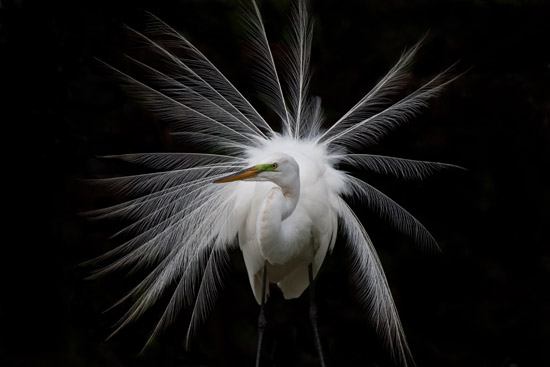 The infamous Dead Parrot Sketch from Monty Python’s Flying Circus continues to resonate several generations removed from its creators. One of the most treasured exchanges, between a shady pet shop owner and prospective customer included two immortal comedic words, “Beautiful plumage”, followed by the equally impressive retort, “The plumage don’t enter into it. It’s stone dead.”
The infamous Dead Parrot Sketch from Monty Python’s Flying Circus continues to resonate several generations removed from its creators. One of the most treasured exchanges, between a shady pet shop owner and prospective customer included two immortal comedic words, “Beautiful plumage”, followed by the equally impressive retort, “The plumage don’t enter into it. It’s stone dead.”
Though utterly silly this conversation does point towards a deeper and very ironic truth: that humans so eager to express their status among their peers do this by exploiting another species. Thus, the stunning white plumage of the Great White Egret proved to be its undoing, almost. So utterly sought after were the egrets’ feathers that both males and females were hunted close to extinction. And, in a final ironic twist, the near extinction of these great birds inspired the Audubon campaigns and drove legislation to curb the era of fancy feathers.
[div class=attrib]More courtesy of the Smithsonian[end-div]
I’m not the only one who has been dazzled by the egret’s feathers, though. At the turn of the 20th century, these feathers were a huge hit in the fashion world, to the detriment of the species, as Thor Hanson explains in his new book Feathers: The Evolution of a Natural Miracle:
One particular group of birds suffered near extermination at the hands of feather hunters, and their plight helped awaken a conservation ethic that still resonates in the modern environmental movement. With striking white plumes and crowded, conspicuous nesting colonies, Great Egrets and Snowy Egrets faced an unfortunate double jeopardy: their feathers fetched a high price, and their breeding habits made them an easy mark. To make matters worse, both sexes bore the fancy plumage, so hunters didn’t just target the males; they decimated entire rookeries. At the peak of the trade, an ounce of egret plume fetched the modern equivalent of two thousand dollars, and successful hunters could net a cool hundred grand in a single season. But every ounce of breeding plumes represented six dead adults, and each slain pair left behind three to five starving nestlings. Millions of birds died, and by the turn of the century this once common species survived only in the deep Everglades and other remote wetlands.
This slaughter inspired Audubon members to campaign for environmental protections and bird preservation, at the state, national and international levels.
[div class=attrib]Image courtesy of Antonio Soto for the Smithsonian.[end-div]
